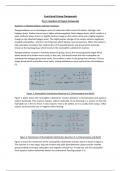Essay
Unit 14 Aim A: Reactions and Properties of Functional Group Compounds Assignment (DISTINCTION)
- Institution
- PEARSON (PEARSON)
This is my distinction grade assignment for unit 14 aim A on the reactions and properties of functional group compounds, including alcohols, aldehydes, ketones and more. All criteria were met and I was awarded distinction. If you have any questions or concerns, please do not hesitate to get in ...
[Show more]



